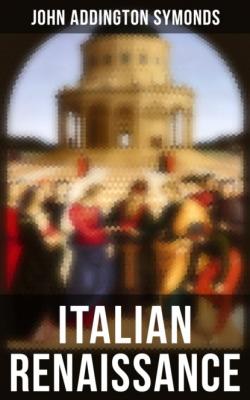Italian Renaissance. John Addington Symonds
Читать онлайн.| Название | Italian Renaissance |
|---|---|
| Автор произведения | John Addington Symonds |
| Жанр | Документальная литература |
| Серия | |
| Издательство | Документальная литература |
| Год выпуска | 0 |
| isbn | 4064066394745 |
John Addington Symonds
Italian Renaissance
All 7 Volumes
Published by
Books
- Advanced Digital Solutions & High-Quality eBook Formatting -
2020 OK Publishing
EAN 4064066394745
Table of Contents
Volume 1
Table of Contents
CHAPTER I. THE SPIRIT OF THE RENAISSANCE.
CHAPTER III. THE AGE OF THE DESPOTS.
CHAPTER V. THE FLORENTINE HISTORIANS.
CHAPTER VI. 'THE PRINCE' OF MACHIAVELLI.
CHAPTER VII. THE POPES OF THE RENAISSANCE
CHAPTER VIII. THE CHURCH AND MORALITY.
PREFACE.
This volume is the First Part of a work upon the 'Renaissance in Italy.' The Second Part treats of the Revival of Learning. The Third, of the Fine Arts. The Fourth Part, in two volumes, is devoted to Italian Literature.
Owing to the extent of the ground I have attempted to traverse, I feel conscious that the students of special departments will find much to be desired in my handling of each part. In some respects I hope that the several portions of the work may complete and illustrate each other. Many topics, for example, have been omitted from Chapter VIII. in this volume because they seemed better adapted to treatment in the future.
One of the chief difficulties which the critic has to meet in dealing with the Italian Renaissance is the determination of the limits of the epoch. Two dates, 1453 and 1527, marking respectively the fall of Constantinople and the sack of Rome, are convenient for fixing in the mind that narrow space of time during which the Renaissance culminated. But in order to trace its progress up to this point, it is necessary to go back to a far more remote period; nor, again, is it possible to maintain strict chronological consistency in treating of the several branches of the whole theme.
The books of which the most frequent use has been made in this first portion of the work are Sismondi's 'Républiques Italiennes'; Muratori's 'Rerum Italicarum Scriptores'; the 'Archivio Storico Italiano'; the seventh volume of Michelet's 'Histoire de France'; the seventh and eighth volumes of Gregorovius' 'Geschichte der Stadt Rom'; Ferrari's 'Rivoluzioni d' Italia'; Alberi's series of Despatches; Gino Capponi's 'Storia della Repubblica di Firenze'; and Burckhardt's 'Cultur der Renaissance in Italien.' To the last-named essay I must acknowledge especial obligations. It fell under my notice when I had planned, and in a great measure finished, my own work. But it would be difficult for me to exaggerate the profit I have derived from the comparison of my opinions with those of a writer so thorough in his learning and so delicate in his perceptions as Jacob Burckhardt, or the amount I owe to his acute and philosophical handling of the whole subject. I must also express a special debt to Ferrari, many of whose views I have adopted in the Chapter on 'Italian History.' With regard to the alterations introduced into the substance of the book in this edition, it will be enough to say that I have endeavored to bring each chapter up to the level of present knowledge.
In conclusion, I once more ask indulgence for a volume which, though it aims at a completeness of its own, is professedly but one part of a long inquiry.
CHAPTER I.
THE SPIRIT OF THE RENAISSANCE.
Difficulty of fixing Date—Meaning of Word Renaissance—The Emancipation of the Reason—Relation of Feudalism to the Renaissance—Mediæval Warnings of the Renaissance—Abelard, Bacon, Joachim of Flora, the Provençals, the Heretics, Frederick II.—Dante, Petrarch, Boccaccio—Physical Energy of the Italians—The Revival of Learning—The Double Discovery of the World and of Man—Exploration of the Universe and of the Globe—Science—The Fine Arts and Scholarship—Art Humanizes the Conceptions of the Church—Three Stages in the History of Scholarship—The Age of Desire—The Age of Acquisition—The Legend of Julia's Corpse—The Age of the Printers and Critics—The Emancipation of the Conscience—The Reformation and the Modern Critical Spirit—Mechanical Inventions—The Place of Italy in the Renaissance.
The word Renaissance has of late years received a more extended significance than that which is implied in our English equivalent—the
